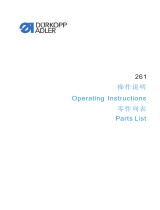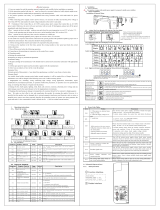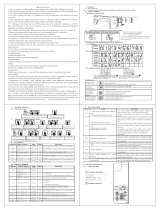
1. Safety Precaution
(1). Work environment ………………………………………………………………………………………
(2). Safety in installation ………………………………………………………………………………………
(3). Safety in operating ……………………………………………………………………………………
(4). Safety in maintenance and repairs ………………………………………………………………………
(5). Regulation in maintenance and repairs …………………………………………………………………
(6). Danger and caution signs ………………………………………………………………………………
(7). Warranty information ………………………………………………………………………………
2. Installation and Adjustment
(1). Control box installation ………………………………………………………………………………
(2). Operation box installation ………………………………………………………………………………
(3). Speed control unit adjustment ………………………………………………………………………
(4). Speed control unit Forward / Backward function & force adjustment ……………………………
(5). Installation of the synchronizer ………………………………………………………………………
(6). Assembly of hand wheel ……………………………………………………………………………
(7). Installation of hand wheel ………………………………………………………………………………
(8). Needle position adjustment ……………………………………………………………………………
3. Power Connection and Grounding
(1). Single phase and three phase connection …………………………………………………………
(2). How to connect 1Φ / 220 V power from 3 Φ / 380 V power source ……………………………
(3). The load balance when use 1Φ / 220 V motor used on 3 Φ / 220 V power source …………
(4). How to change solenoid supply voltage (DC 24 V or 30 V) ……………………………………
4. Part Name of the Control Box
(1). Use the following numbers cross reference with the control box picture ……………………
(2). Exterior of the control box …………………………………………………………………………
5. Key Function on Operation Panel / Box
(1). When use with F-10 mini panel / operation box …………………………………………………
(2). When use with C-60 operation box …………………………………………………………………
6. Parameter Adjustment
(1). How to enter【Normal Mode】 …………………………………………………………………………
(2). How to enter【Parameter Mode】level ……………………………………………………………
(3). How to set the【Parameter Value】with F-10 operation panel ……………………………………
(4). How to set the【Parameter Value】with C-60 operation panel ……………………………………
(5). Value setting for A、B、C、D key in the【Parameter Value】……………………………………
Model : HVP - 20 Series
Contents
Page
1
1
2
2
2
2
2
3
3
3
4
5
5
5
6
7
7
8
8
9
10
11
12
15
15
15
16
16































